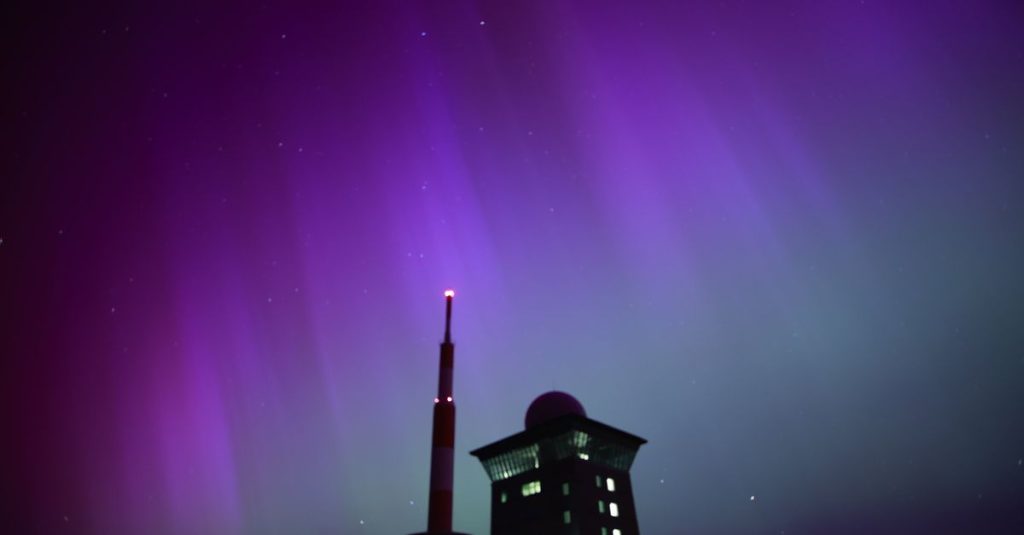An unusually strong solar storm hitting Earth could produce northern lights in the U.S. this weekend and potentially disrupt power and communications. The National Oceanic and Atmospheric Administration issued a rare severe geomagnetic storm warning when a solar outburst reached Earth on Friday afternoon, hours sooner than anticipated. The effects were due to last through the weekend and possibly into next week. Operators of power plants and spacecraft were advised to take precautions by NOAA, as well as the Federal Emergency Management Agency. While most people on Earth won’t have to do anything, the storm could produce northern lights as far south in the U.S. as Alabama and Northern California, although experts stressed that it would not be the dramatic curtains of color normally associated with the northern lights, but more like splashes of greenish hues.
The most intense solar storm in recorded history, in 1859, prompted auroras in central America and possibly even Hawaii. While experts do not anticipate a similar event happening now, the current storm poses a risk for high-voltage transmission lines for power grids and satellites, which could disrupt navigation and communication services on Earth. An extreme geomagnetic storm in 2003 took out power in Sweden and damaged power transformers in South Africa, highlighting the potential impact of such storms on Earth’s infrastructure. Signals between GPS satellites and ground receivers could be scrambled or lost during the storm, but due to the presence of numerous navigation satellites, any outages are not expected to last long. While the storm is ongoing, the Space Weather Prediction Center recommended that extremely sensitive instruments on NASA science satellites be turned off to avoid damage.
The solar activity causing the current storm is part of the sun’s ramping up as it approaches the peak of its 11-year cycle. The sun has been producing strong solar flares since Wednesday, resulting in at least seven outbursts of plasma, known as coronal mass ejections, that can contain billions of tons of plasma and magnetic field from the sun’s outer atmosphere, or corona. The flares seem to be associated with a sunspot that’s 16 times the diameter of Earth, according to NOAA. NASA stated that the storm posed no serious threat to the seven astronauts aboard the International Space Station, with the biggest concern being increased radiation levels. If necessary, the crew could move to a better-shielded part of the station. Increased radiation levels could also threaten some of NASA’s science satellites, leading to the possibility of turning off sensitive instruments to avoid damage.
The National Weather Service and other organizations have been monitoring the storm closely to provide updates and alerts as needed. The Space Weather Prediction Center issued the first G4 (Severe) geomagnetic watch since 2005, indicating that the aurora tonight/tomorrow morning may become visible over much of the northern half of the country and possibly as far south as Alabama to northern California. Scientists have been observing the solar activity with several sun-focused spacecraft to better understand these phenomena and their potential impacts on Earth. While the storm could disrupt power and communications and produce northern lights, it is relatively mild compared to the most intense solar storms in history. Even so, precautions are being taken to protect power grids, satellites, and sensitive instruments on NASA science satellites during this event.
In conclusion, the unusually strong solar storm hitting Earth this weekend could produce northern lights in the U.S. and potentially disrupt power and communications. While the impact on most people on Earth may be minimal, operators of power plants and spacecraft have been advised to take precautions. The storm poses a risk for high-voltage transmission lines for power grids and satellites, which in turn could disrupt navigation and communication services on Earth. NASA and other organizations are monitoring the situation closely to provide updates and ensure the safety of astronauts aboard the International Space Station and sensitive instruments on science satellites. Despite the potential for disruption, scientists are taking advantage of this opportunity to observe solar activity and better understand these phenomena for future preparedness.


